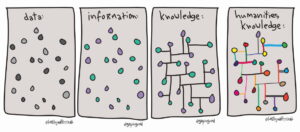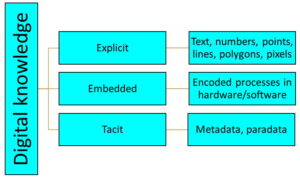
Digital tools increasingly permeate our world, supporting, enhancing, or replacing many of our day-to-day activities in archaeology as elsewhere. Many of these devices lay claim to being ‘smart’, even intelligent, though more often than not this has more to do with sleight of hand and invisible software functionality than any actual intelligence. As Ian Bogost has recently observed, the key characteristic of these so-called smart devices is not intelligence so much as online connectivity, the realisation of which brings with it external surveillance and data-gathering (Bogost 2022). Such perceptions of ‘smartness’ might also point to a tendency for us to overestimate the capabilities of digital tools while at the same time minimise their influence.
In this light, I came across an interesting quotation from an anonymous archaeologist cited in Smiljana Antonijević’s book Amongst Digital Humanists: An Ethnographic Study of Digital Knowledge Production who said:
In archaeology, digital technologies such as GIS applications, laser scanning, or databases have been used for decades, and they are as common as a trowel or any other archaeological tool. (Antonijević 2016, 49).
The quote is clearly provided without context, but leaving the hyperbole aside there seems to be the implication that there is nothing special or different about digital tools relative to any non-digital or analog tool. The same anonymous person goes on to say:
There is no real distinction between digital and non-digital tools in the work of archaeologists … (Antonijević 2016, 49).
This is an interesting perspective – the idea that computers, digital instruments, and the software we run on them are just tools that we use, that there’s nothing unique about them. I don’t know how common this view is, but I suspect many would agree with this: computers are simply tools, much like trowels, spades, and wheelbarrows. The computer is therefore no more than part of the general toolkit used by archaeologists.
This conception of the computer as tool carries within it a tendency to make technology seem neutral – the tool is neither good nor bad but is capable of being put to good or bad use. It is the equivalent of the aphorism that guns do not kill people, people kill people. What gives the tool direction is the user; the tool is simply how we as users achieve our desired objectives. Our focus is therefore on how the tool is implemented or used, an approach which can encourage a view of computer-based tools as theoretically neutral, essentially empty vessels into which data are poured. As a result, evaluations of computer use often tend to be limited to how they are applied, while consideration of social, cultural, and philosophical issues associated with their use is frequently lacking.
I would argue that the scope of digital technologies is much greater than most typical tools – after all, they are simultaneously tools for writing, reading, drawing, mapping, storing, retrieving, communicating, analysing, reconstructing, integrating, and disseminating our data and information. For example, Figure 1 is adapted from a diagram by Ian Hodder which he uses to show the way that archaeological knowledge is created through the mediation of interpretation between the past and the present. Most tools will be applied in one or other area – for instance, we use a trowel as a means of revealing data, or a measuring tape to capture an observation – but they don’t operate across the spectrum. However, digital tools do: we use them in data capture, in observation, in interpretation, and, I would suggest, increasingly in theory too, and often all at the same time. So digital tools influence archaeological knowledge from capture through to interpretation and analysis, and this makes them different from non-digital tools.

Others have characterised this differently. For example, Gary Lock (2003, p.8) has linked the development of archaeological computing with archaeological theory, and he maps the richness and range of data handling that has developed over the years against the developing richness and variety in archaeological explanation over time. He makes no judgement about which was the driving force – technology or theory – which in any case is something of a chicken and egg question and rather over-deterministic. However, the model suggests that the growth in digital capacity and capability parallels developments in archaeological thought. Can the same be said for a trowel or wheelbarrow? A similar model by Gareth Beale and Paul Reilly (2017, fig 1) makes the point more elaborately. For example, it shows the introduction through time of different categories of archaeological tools alongside developments in archaeological theory, from statistics and databases through to 3D GIS, computational photography and the like. Such relationships are inevitably more complicated than these models would suggest, but the general point stands: that digital tools have influenced archaeological knowledge since the earliest days of computer usage, and one might argue that as computer power has grown over time, so the role and influence of digital tools in creating archaeological knowledge has increased.
This relationship is not a straightforward one. Our derivation of archaeological knowledge is a complex process and digital devices are involved from beginning to end: from the prospection and discovery of archaeological data, through its categorisation and representation, to the analytical tools we use to translate data into knowledge. Consequently, our relationships with data and with the digital devices which handle those data in knowledge creation have significant implications for archaeology, but these relationships can be difficult to characterise.
For example, consider a classic model of knowledge (Figure 2). Typically, knowledge can be divided into three types: explicit knowledge (things that are recorded in documents, artefacts, etc.), embedded knowledge (processes, rules, procedures for doing things), and tacit knowledge (things that are typically a result of custom or instinct and are rarely articulated).

By comparison, Figure 3 suggests how this maps onto digital technologies. Explicit digital knowledge seems relatively straightforward – it consists of data stored as text, numbers, points, lines, polygons, pixels, etc.. Embedded digital knowledge is another matter – here the procedures, rules and processes are encoded within hardware and software, which means that for the most part they operate like a black boxes which we often have little knowledge about or control over. Tacit digital knowledge is also problematic – digital devices are usually poor at capturing these aspects and nuance, uncertainty, unreliability, bias and so on in our data mostly goes unrecognised. Making tacit knowledge explicit is challenging (and even contradictory) and I’ve discussed approaches to this elsewhere (Huggett 2020, p.9ff, and see also Hacıgüzeller et al. 2021, for example). We may try and capture some of this through metadata or other accompanying documentation, but this is usually a poor reflection because of the difficulty of expressing tacit information and in any case is easily ignored and set aside.

In an archaeology increasingly defined by and generated using digital tools, an understanding of archaeological knowledge requires a critical understanding of the potential and limitations of the devices we use in its creation. Such understanding is difficult because of the complexity and variability of archaeological data, combined with the speed, accessibility, and computability of digital technologies, insulated by the quantity, usability, and flexibility of the data and tools, and a growing assumption that more data is better, that big datasets overcome problems with bias and variability in data as computers and digital tools become ever more powerful. However, the effort involved will lead to a richer, more critical understanding of our data and methods and tools, and enable us to develop richer, denser, and more rigorous knowledge about the past.
[Parts of this text are derived from a presentation made to the BE-ARCHAEO graduate summer school at Okayama University, part of the MSCA-RISE BE-ARCHAEO project. I thank Eliano Diana (Department of Chemistry, University of Turin) and his colleagues for the invitation to speak.]
References
S. Antonijević (2016) Amongst Digital Humanists: An Ethnographic Study of Digital Knowledge Production (Palgrave Macmillan: New York).
G. Beale & P. Reilly (2017) ‘Digital Practice as Meaning Making in Archaeology’, Internet Archaeology 44. https://doi.org/10.11141/ia.44.13
I. Bogost (2022) ‘Your Smart Thermostat Isn’t Here to Help You’, The Atlantic (September 26, 2022) https://www.theatlantic.com/technology/archive/2022/09/who-controls-smart-thermostat-temperature-nest-ecobee/671559/
A. Botha, D. Kourie, & R. Snyman (2008) Coping with Continuous Change in the Business Environment: Knowledge management and knowledge management technology (Chandos: Oxford).
Hacıgüzeller, P., Taylor, J.S. and Perry, S. (2021) ‘On the Emerging Supremacy of Structured Digital Data in Archaeology: A Preliminary Assessment of Information, Knowledge and Wisdom Left Behind’, Open Archaeology, 7(1), pp. 1709–1730. https://doi.org/10.1515/opar-2020-0220.
I. Hodder (1992) Theory and Practice in Archaeology (Routledge: London).
J. Huggett (2020) ‘Capturing the Silences in Digital Archaeological Knowledge’, Information, 11(5), art. 278. https://doi.org/10.3390/info11050278.
G. Lock (2003) Using Computers in Archaeology: Towards virtual pasts (Routledge: London).


